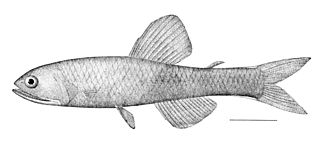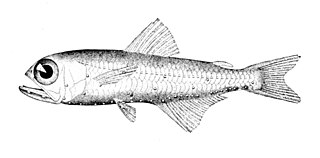
Astyanax is a genus of freshwater fish in the family Characidae of the order Characiformes. Some of these fish, like many of their relatives, are kept as aquarium pets and known collectively as tetras. With around 150 described species and new ones being described yearly, this genus is among the largest of the entire order; Hyphessobrycon also has more than 145 species and which one is larger at any one time depends on whether more species have been recently described in one or the other. The blind and colorless cave tetra of Mexico is a famous member of the genus, but its taxonomic position is disputed: Some recognize it as part of the Mexican tetra and this is supported by phylogenetic evidence, but others recognize the cave form as a separate species, A. jordani.
Percy Alexander Hulley is a South African zoologist and ichthyologist.. He is a research associate at the South African Museum and has described many species of fish including the taillight shark.

Protomyctophum is a genus of lanternfishes.

Electrona is a genus of lanternfishes in the family Myctophidae.

Lampanyctus is a genus of lanternfishes.

Ceratoscopelus is a genus of lanternfish.

Gymnoscopelus is a genus of lanternfishes. The name is from the Greek gymnos, "naked" and skopelos, "lanternfish."

Diaphus is a genus of lanternfishes. It is the most species-rich lanternfish genus.

Astroblepus is a genus of fish in the family Astroblepidae found in South America and Panama. This genus is the only member of its family. These catfishes are primarily found in torrential streams in the Andean area. Astroblepus pholeter and A. riberae are troglobites adapted to living in subterranean water systems. These species are typically small, less than 10 cm (4 in). The largest species reaches 30 cm (1 ft). These fish have suckermouths like those of loricariids. They have two pairs of barbels, maxillary and nasal. The dorsal fin spine lacks a locking mechanism. These fish also have odontodes, tiny teeth on their skin. All species exhibit a conical, pointy type on their fin rays like that found in other loricarioids; other species also exhibit a blunt type that is only found on their skin.

Peckoltia is a genus of small South American armored suckermouth catfishes. Many of these fish are popular aquarium fish.

Myctophum is a genus of lanternfishes, some species of which, such as M. punctatum are noted for having the Stylophthalmine trait in their larval form.

Benthosema is a genus of lanternfishes.
Diogenichthys is a genus of lanternfishes.

Hygophum is a genus of lanternfishes.
Nannobrachium is a genus of lanternfishes.
Stenobrachius is a genus of lanternfishes.
The northern lampfish, also known as smallfin lanternfish, is a small oceanic fish in the family Myctophidae. First described by husband and wife ichthyologists Carl H. and Rosa Smith Eigenmann in 1890, it is named for the numerous small round photophores that line the ventral surface of its head and body.

Geophagini is a tribe of cichlids from the subfamily Cichlinae, the American cichlids. It is the sister taxon to the clade which includes the Cichlasomatini and Heroini. Fishes in the Geophagini are distributed from Panama south to Argentina, it is the most speciose of the seven tribes within the Cichlinae and it is subdivided into three sub-tribes, Acarichthyina, Crenicaratina, and Geophagina which together contain over 200 species. Geophagines show morphological and behavioural specialisations to enable them to sift the substrates within their mouths so that they can separate benthic invertebrates from substrates dominated by sand or silt.

Symbolophorus evermanni is a species of fish in the family Myctophidae. It is widely distributed in the Indian and Pacific Oceans. The specific name evermanni honors ichthyologist Barton Warren Evermann. It is also known as Evermann's lanternfish or Evermann's lantern fish.
Symbolophorus californiensis is a species of fish in the family Myctophidae.














